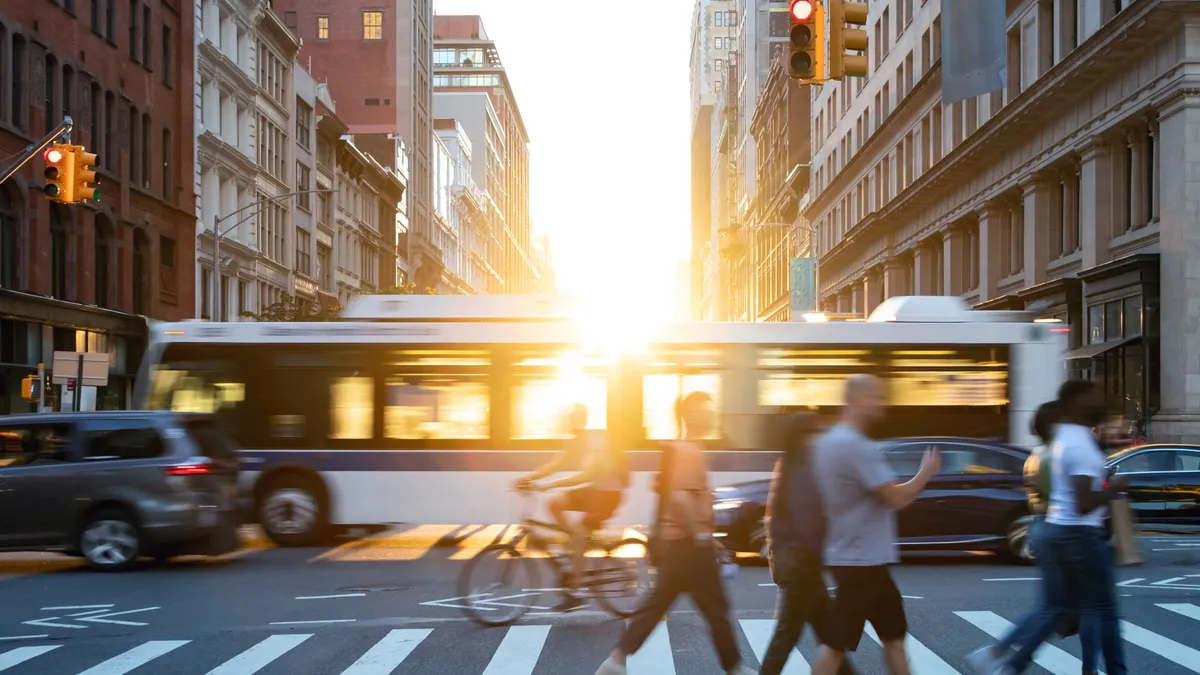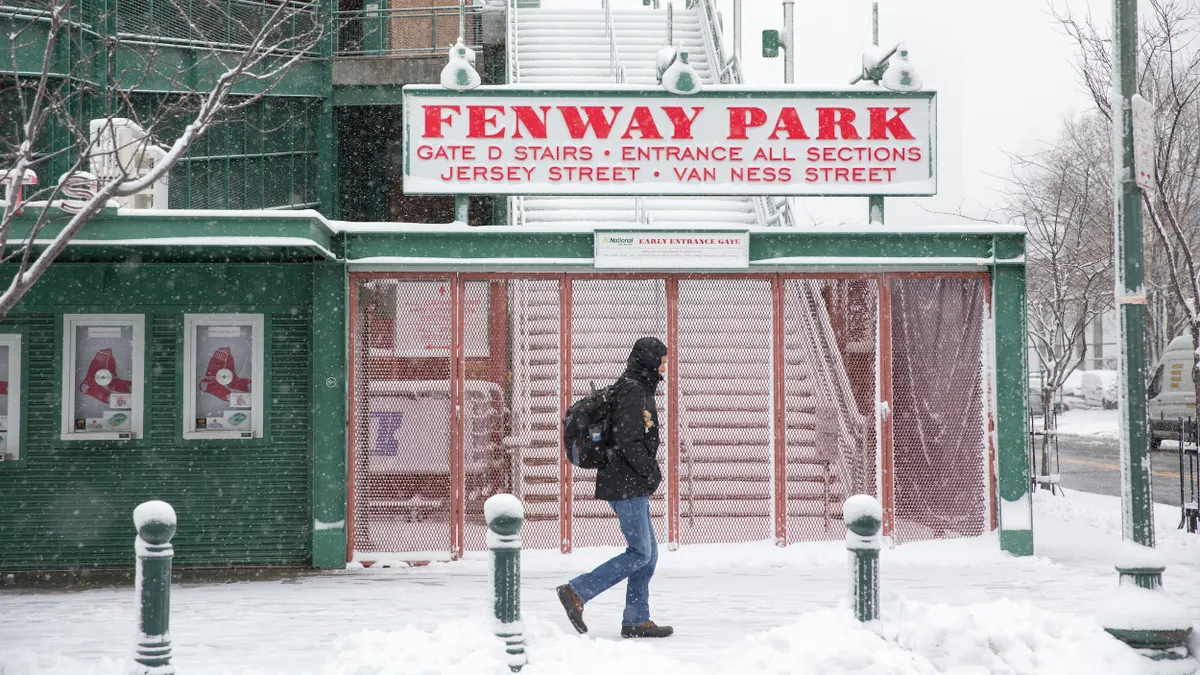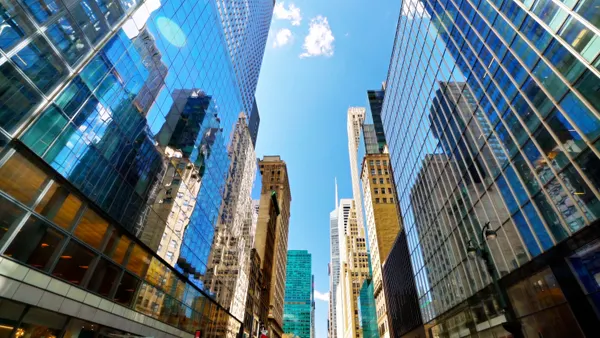Flying taxis, high-speed rail, emissions-free buildings and transportation: Some long-held dreams of urban futurists are moving forward in 2024.
Cities also are taking advantage of increased federal funding and growing public sentiment to address some long-neglected issues, like the shortage of affordable housing and the impacts of climate change, especially on disadvantaged communities. At the same time, however, cities are confronting problems that stem from the pandemic: empty office buildings, hollowed-out downtowns and public transit systems hobbled by changes in commuting. In some cases, new technologies are providing new solutions; other new technologies, like generative AI, are cause for both optimism and caution by city leaders.
Below is a selection of the trends that Smart Cities Dive will be keeping a watchful eye on in the coming year. Which trends shaping U.S. cities are you following in 2024? Let us know at [email protected].
More building decarbonization policies will get off the ground, but not without snags.
Efforts to get fossil fuels out of buildings will continue in 2024 as cities face looming deadlines for their goals to reduce greenhouse gas emissions. Bans or restrictions on natural gas hookups in new construction continue to proliferate in cities and, more recently, at the state level.
However, cities are closely watching the progression of several lawsuits filed by gas and building contractor groups to block such building electrification rules. These opponents are hoping more courts will follow the federal appeals court that last year struck down Berkeley, California’s first-in-the-nation gas ban in new buildings. That decision already has caused some jurisdictions to rethink their own rules to avoid legal threats.
State and local governments expect to make progress on passing building performance standards, which have emerged in recent years as a key policy to drive down climate pollution from existing buildings. Dozens of local and state officials have committed to adopting such rules by Earth Day 2024 or 2026 as part of the National BPS Coalition, which President Joe Biden launched in 2022. Despite this federal support, some building performance standards and related rules may still face pushback from building owners and operators who cite cost and technical concerns.
Cities will also look closer at how to drive down buildings’ embodied carbon — the greenhouse gas emissions associated with the entire lifecycle of building products. Such policies may include “Buy Clean” initiatives promoting the procurement of climate-friendly materials, building code changes and financial incentives.
Cities will increase climate resilience — or suffer the consequences.
Extreme weather — made more frequent and severe by climate change — will continue to batter communities in 2024, disproportionately harming historically underserved, disadvantaged communities. Already, some scientists are bracing for 2024 to be hotter on average than the planet’s record heat in 2023.
Even though the number of city- and state-level adaptation plans and actions has increased 32% since 2018, such efforts are still insufficient to keep pace with future climate change impacts, according to the Fifth National Climate Assessment. In other words, cities will need to do more, and faster, in 2024 to protect their residents and infrastructure from mounting risks. Each community will determine which strategies it thinks will work best, from leveraging nature-based solutions to modernizing building codes to encouraging denser development in lower-risk areas.
They will have federal resources to draw on: The Biden administration has made billions of dollars available for climate resilience projects, and federal agencies continue to tweak grant application processes to help money more equitably reach local governments that can’t compete with the staff and expertise of larger cities.
Disaster recovery will raise even more sticky questions in 2024. Last year brought a record 28 billion-dollar weather disasters, and the federal Disaster Relief Fund is stretched thin. Some emergency management experts have criticized the U.S. process for helping people recover from disasters as too slow and overly complicated, and federal lawmakers continue to advocate for changes they believe would streamline it.
U.S. high-speed rail will continue to gain momentum.
High-speed rail advocates took heart in December when the White House announced more than $6 billion in grants for two California projects: one under construction in the state’s Central Valley that aims to connect Los Angeles and San Francisco and the Brightline West project poised to begin construction this year between Southern California and Las Vegas.
But that’s not all. Last August, a dormant project to link Dallas and Houston gained new life when Amtrak said it may work with Texas Central Partners to advance its planning and analysis. That project was one of seven high-speed rail projects that were each awarded up to $500,000 grants on Dec. 8 under the Federal Railroad Administration’s corridor identification and development program.
Other high-speed rail ambitions the grants are supporting — all in the planning stages — include a project to connect Pacific Northwest cities with Vancouver, Canada; a proposed Atlanta-to-Charlotte, North Carolina, route; and a proposed corridor line between Fort Worth, Texas, and Houston. The High-Speed Rail Alliance sees even more opportunities for fast trains in regions around the country.
“The tide is turning,” said Andy Kunz, president and CEO of the U.S. High Speed Rail Association, in a Dec. 7 statement. “America will soon join the club of 26 nations that enjoy the spectacular economic, environmental, and safety benefits of bullet trains.”
Flying taxis may finally take off.
The race to be the first electric vertical takeoff and landing aircraft manufacturer to fly passengers commercially is on, and it could happen this year. Colloquially known as flying taxis, eVTOLs take off and land vertically like a helicopter, then shift into forward flight with wing-mounted electrically-powered propellers.
Joby Aviation is eyeing New York City and Los Angeles routes in partnership with Delta Air Lines. In November, Joby flew its eVTOL aircraft from New York City’s downtown heliport in Manhattan as New York City Mayor Eric Adams and local news crews watched. Adams said the city would add the necessary infrastructure to the heliport to enable eVTOL operations. Archer Aviation and United Airlines plan to fly between the downtown heliport and Newark Liberty International Airport in New Jersey beginning next year. The two companies also have plans for a route between downtown Chicago and O’Hare International Airport.
Along with their commercial airline partnerships, Archer and Joby enjoy close ties with global automotive manufacturers, Stellantis with Archer and Joby with Toyota. They aren’t the only automakers looking to the sky. Supernal, a unit of Hyundai Motor Group, unveiled its concept aircraft at the tech trade show CES 2024 on Jan. 9. The vehicle, which fits four passengers and a pilot, is designed to cruise 120 mph at a 1,500-foot altitude to meet typical city operation needs of 25- to 40-mile trips, the company said in a press release.
Honda, which has manufactured and sold the HondaJet since 2006, is also developing an eVTOL, but it will have a gas turbine hybrid power unit for a longer flying range of about 250 miles.
In the U.S., the Federal Aviation Administration will have the final say on when these aircraft can begin carrying passengers. The agency released a 40-page implementation plan for advanced air mobility that anticipates operations to begin between 2025 and 2028.
Public transit continues to struggle with post-pandemic commuting changes.
U.S. transit ridership nationally remained stuck at about 77% of pre-pandemic numbers through much of 2023, per data from the American Public Transportation Association. That’s created both financial and operational problems for many transit systems that were structured around twice-a-day peaks Monday through Friday.
That trend is likely to continue. Gallup estimates that 40% of employees who are capable of working remotely have transitioned from a fully in-office regimen to hybrid or fully remote work. By 2025, 32.6 million workers — or 22% of the workforce — will be working remotely, according to Upwork estimates cited by Forbes.
San Francisco is the poster child for empty office space, hitting a 35.9% vacancy rate at the end of 2023. That’s reflected in the city’s transit ridership. The San Francisco Municipal Transportation Agency’s buses and trains saw average weekday ridership in December 2023 at 65% of the same month in 2019, while the Bay Area Rapid Transit system carried 38% of its December 2019 weekday traffic.
Transit could benefit from cities and developers converting office space to other uses, according to a November study from the Urban Institute. The results show that transit stations retain substantially more riders in areas with diverse land use rather than those dominated by one purpose.
Chicago rail stations in areas with more variation in land-use types, including open space and parks, saw the highest ridership recovery, the study found. The researchers recommend that transit agencies work with local governments to enable land-use changes that boost affordable housing near stations and look within their own landholdings for opportunities to create high-density, mixed-use development.
Housing, particularly affordable housing, will remain a priority as cities rethink their downtowns.
The continued housing affordability crisis continues to force every level of government to explore strategies to increase housing supply. Common policy solutions in 2024 will range from relaxing single-family zoning rules to eliminating parking minimums that drive up the cost of construction.
More cities, with backing from the Biden administration, will try to encourage nontraditional housing development, including accessory dwelling units and conversion of commercial spaces like office buildings and malls into residential or mixed-use developments.
The push for office-to-residential conversions comes as cities continue to reimagine how downtowns can thrive in a post-pandemic world in which many employees still work from home. Other downtown revitalization strategies cities are pursuing include increasing walkability and safety as well as attracting and retaining new businesses.
Rising homelessness will remain a challenge for cities as inflation, higher interest rates and affordable housing scarcity drive up housing costs. Some cities will continue to experiment with new approaches to meet the needs of people experiencing homelessness, such as tiny homes.


















